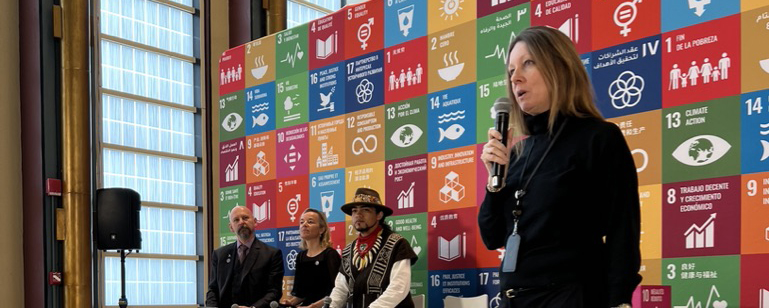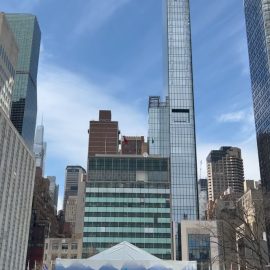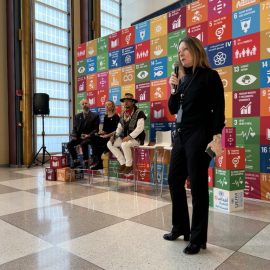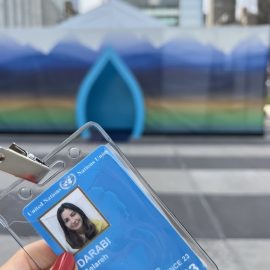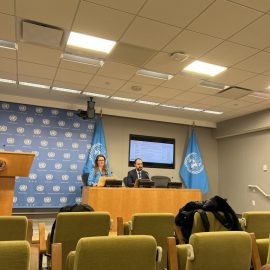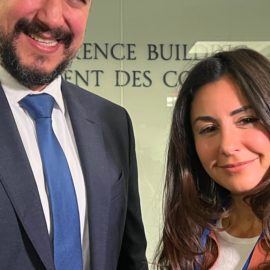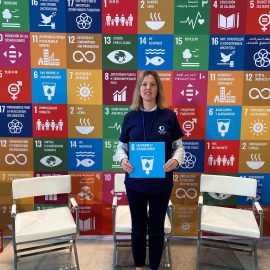By Gelareh Darabi
Urgency. That’s the first word that comes to mind when I think of this year’s UN Water Conference held March 22-24 in New York.
“When we emerge from this conference, we really need to do bolder action, because we do not have the time. We waited 46 years to be here. We do not have another 46 years”, said Professor Musonda Mumba, Secretary General of the RAMSAR Convention on Wetlands in her opening remarks of the Sustainable Development, Water and Biodiversity live panel.
It’s hard to believe, but very true. This was the first UN Water Conference to be held in almost 50 years. Everyone mentioned it. They rolled their eyes, shook their heads in disbelief and used this point to emphasize how little attention global water issues had gotten over the past half a century.
“Water has not been taken seriously. It was not part of the original Paris Agreement in climate change negotiations. We didn’t pay much attention to it for food production, for better sanitation and health. We have not done proper planning for water, for better water management when it comes to the violations of basic human rights”, said Dr. Kaveh Madani, Director of the United Nations University Institute for Water, Environment & Health.
Dr. Madani was at the conference to launch a new report, the Global Water Security 2023 Assessment, which warns the world is not on track to meet the critical UN Sustainable Development Goals (SDG) set for 2030. This is where the pressure of a ticking clock took over most panels and discussions at this year’s event.
The SDG global framework was first established in 2015. All UN member states approved the commitment and set out 17 goals, 169 targets and 230 indicators to meet during the 15-year agenda. The SDGs address everything from poverty to hunger to gender equality and environmental degradation. Water is a key part of many of the commitments. For example, goal number six is centered around “ensuring the availability and sustainable management of water and sanitation for all”.
This framework can seem to many to be all-encompassing and overwhelmingly far-reaching, but what it does is finally start to acknowledge the interconnectivity between so many ecosystems here on Earth. With so much research linking water instability to economic hardship, gender inequality and even violence and social unrest, this is where global water experts, like Madani, have long been pointing out these larger links.
“If we don’t make progress in distributing proper water and sanitation to the people of this planet all our agendas to save the world, to address the triple planetary crisis of climate change biodversity loss and pollution would fail,” said Madani.
In many ways, decades of relentless environmental education and campaigning have finally helped the public realize how fragile and deeply woven our world truly is. Every major decision, whether it be economic or social, has a ripple effect and it is often the environment, animals and people who are most impacted.
This is where stakeholders, outside of governments and NGOs, are starting to show interest.
More and more, global companies are allocating attention and funding to support research, projects and organizations who have a proven track record of impacting communities and ecosystems. In some cases, it’s greenwashing. A move to eco-align their public image, but more and more demands for larger corporate focus on the environmental issues, like clean water, is coming from employees within the companies themselves.
That’s how Maria Milina, Research Analyst for DWS Research House found herself at this year’s UN event. Within this tightly-woven, global ecosystem there is no escaping that businesses contribute a substantial share to the environmental degradation that we are seeing on a planetary scale. DWS is spearheading research and environmental initiatives as a direct response to their employees’ demands to take responsibility and actively participate in the race to balance and preserve critical ecosystems.
“The UN estimates that the global cost of achieving SDG 6 on water and sanitation exceeds USD 1 trillion per year, or 1.21% of global GDP. Yet, financing flows have long remained well below identified levels. 25% of the world’s population currently lives in water-stressed regions. Yet only 373 companies (13%) of the approximately 2,800 companies in the MSCI All Country World Index (ACWI) already use – or plan to use – an internal hypothetical ‘shadow’ water ‘price’ to assess risk and opportunities, or to encourage change in corporate practices,” said Milina.
For me, the sense of urgency and determination to honor the historic framework felt like a long overdue promise that speaks to us all. No longer can we bury our heads in the sand and declare, “not my ecosystem, not my problem”.
We now know all our actions have a downstream effect.
Gelareh Darabi is an environmental journalist (National Geographic, AJ+), documentary filmmaker and Healthy Seas Ambassador.
What many people don’t know about her is that she started her career in journalism as a fashion reporter, but once she had the personal breakthrough that she had a real interest and knack in science and environment storytelling, she kind of buried this part of her biography. It wasn’t until she made a film about Healthy Seas and the rise of sustainable fashion that she started to see the value in her experience covering the fashion industry.
Once she started investigating fast fashion and the environmental destruction brought about by our throw away culture, she really became passionate about this issue. She committed to only wearing sustainable brands on-camera which trickled into her everyday life as she began “greening” her wardrobe, cosmetics and lifestyle. She say’s it’s a work in progress, but something she’s passionate about sharing.
Follow Gelareh on Instagram



